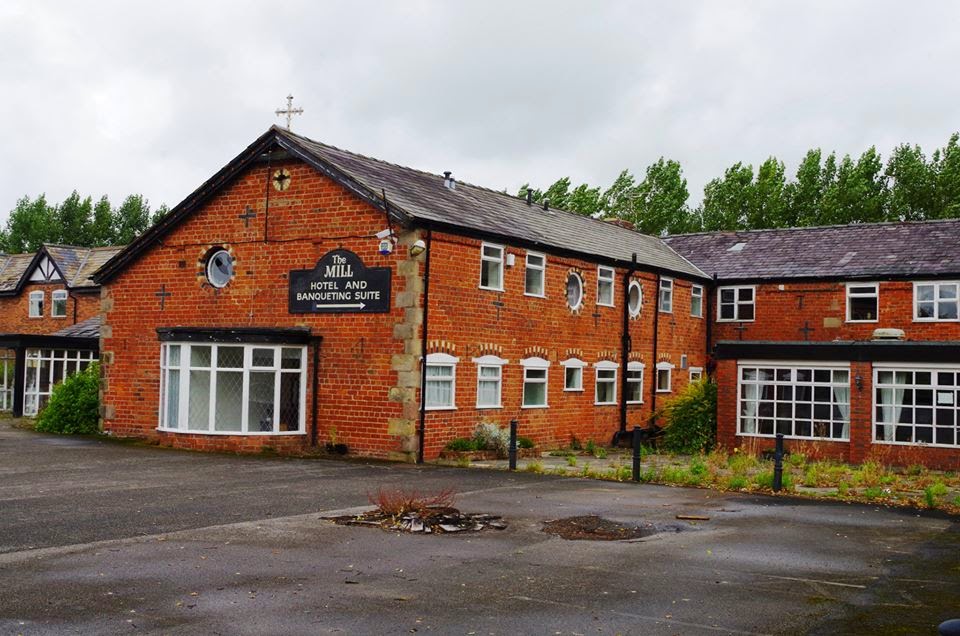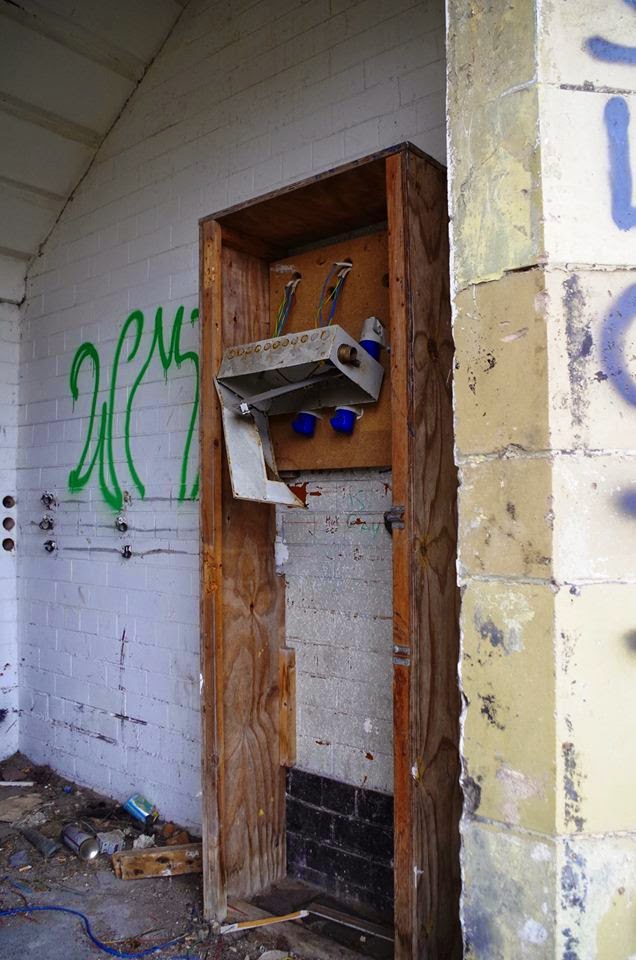According to the website, this hotel "is conveniently located in the heart of Lancashire, close to the M6. It is situated near the charming village of Croston and short drive from Preston Lancashire with many local attractions on hand including Blackpool resort and Camelot Adventure Park." (Hmm . . now another Urbex tourist destination!)It "boasts 45 elegant bedrooms comfortably furnished and equipped with all modern comforts. The main areas and some rooms have free wireless Broadband internet access. Its restaurant "serves a wide selection of drinks and sumptuous meals. The bar features a cosy ambiance in which guests can relax and sip their favourite ales while meeting new friends."
We had a nosey round the back but there really was nothing doing here. No access. Naturally, there was a small collection of broken chairs, getting rather damp outside.
The front porch area had a collection of stained, damp mattresses piled up.
And, of course, there was rather a lot of broken glass.
We peeked through several of the windows, to survey just how trashed the rooms were. Please excuse the reflection but it was impossible to avoid it.
The main reception area was particularly trashed.
|
|
And finally, this sign which promised "the perfect setting for the most important day of your life." The lettering was difficult to read, as it was so faded.
Not any more . . .
|
?

Sunday, 31 August 2014
Fawlty Towers
Wednesday, 27 August 2014
Abandoned Tudor-style tenements
These three blocks of tenements in Liverpool were built by the council and opened in 1912 by the Countess of Derby, as "labourers' dwellings". In their time they must have been the height of style for the city's working classes, with their balconies and indoor bathrooms with running hot water and flushing toilets.
They eventually became student accommodation. In 1993 they were given Grade II listed status. They are currently derelict. The last remaining original-style tenement building in the city.
I visited with my usual 'partner in crime' on a wet morning.
These buildings are indeed looking really unsafe. We didn't go upstairs on this visit for that reason.
We were expecting to come across the odd 'undesirable' character, possibly drinking or partaking of drugs but we didn't meet a single soul.
They eventually became student accommodation. In 1993 they were given Grade II listed status. They are currently derelict. The last remaining original-style tenement building in the city.
I visited with my usual 'partner in crime' on a wet morning.
These buildings are indeed looking really unsafe. We didn't go upstairs on this visit for that reason.
The building is really just an empty shell now.
The balconies. Once a place where people would pass the time of day with neighbours. Now rusting and rotting and empty.
The view from the back.
The walls have long lost their wallpaper and gained street art instead.
This stairwell was in a better state than the others, believe it or not.
Inside one of the ground floor flats. They absolutely stank, despite having no doors and no glass in the windows. I'm convinced that I could smell human waste in one of them!
We were expecting to come across the odd 'undesirable' character, possibly drinking or partaking of drugs but we didn't meet a single soul.
Inside another of the flats.
Nature is definitely fighting back . . and winning!!
This is truly the end of an era for this part of the city. The building is likely to be demolished with new housing replacing it. I would have loved to have visited it during its heyday.
Labels:
abandoned,
architecture,
decay,
derelict,
Urbex
Tuesday, 26 August 2014
The Ark
These staircases were also quite dark, hence the use of a strong flash. Just off the main landing we entered what appeared to be one of the Rabbi's rooms. Whoever used the room appeared to like a drink and possibly needed the use of this wheelchair after he had had his drink!
The Art Deco windows were beautiful, if a little bowed with age.
I don't read Hebrew but it states that this must be recited before the reading.
Then on into the Main Sanctuary. The interior was all carved light oak woodwork.
And views from the balcony on the next floor up.
The seats were all numbered. Many had names on too.
The carpeted stairs to the Bimah.
This is the flooring. It has been carefully taken up and piled into neat piles.
The view from the Bimah that the Rabbi would have.
The Bimah from the front.
This place is in remarkably good condition, considering how long it has been out of use. There was none of the usual damp smell and very little had been trashed. There was no graffiti.
At the other end of the balcony we found the organ.
Then onto the office. It was as if people had just left in a hurry - paperwork, pamphlets and books littered all the desks and surfaces.
The good news is that this building is going to have over £50,000 poured into it, to try to restore it. Apparently, it will be removed from the Buildings at risk register and will once more be used by the local community. Although used for what purpose is not clear yet. A happy ending for a beautiful old building.
Subscribe to:
Comments (Atom)












































































































